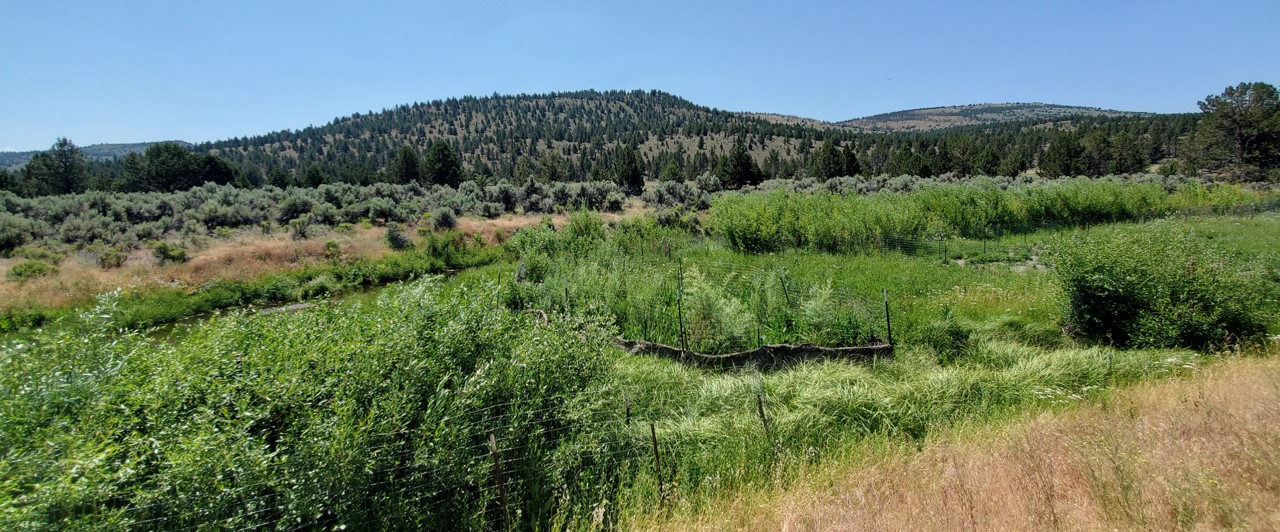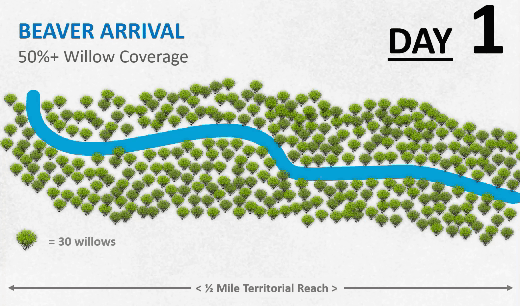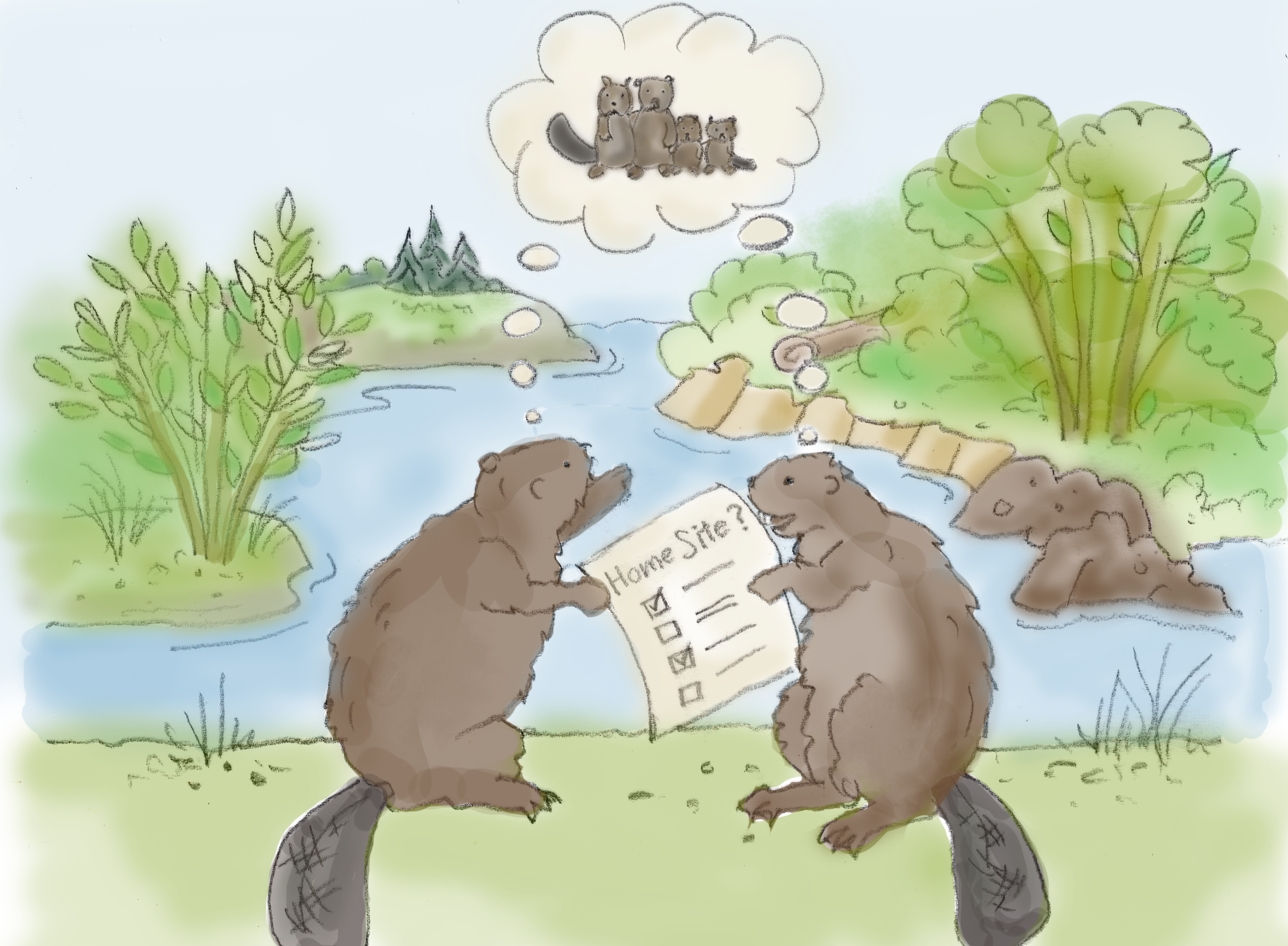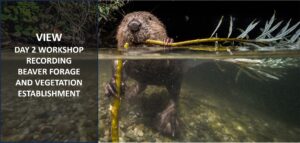WHERE THRIVING BEAVER FAMILIES AND BEAVER MANAGED FLOODPLAINS IS A GOAL, HOW MUCH BEAVER FOOD IS NEEDED TO SUSTAIN LONG-TERM SITE PERSISTENCE?
As Western stream restoration agencies are recognizing the value of beaver-managed floodplains (BMFP) to watershed health and resilience it's a good time to work for beaver recovery in the West! With “long term process based restoration” (LTPBR) as a foundation, its practice often relies on added structure (like BDAs and PALs) to kickstart dynamic, natural processes in a riverscape so systems can begin to heal themselves. But structure alone won't provide what beavers need for long term site persistence.
Beavers Need ALOT of Forage. In the arid, wadable streams of the West, we often see stream degradation so severe that beaver food and forage establishment should be considered an essential component of this work. Without a persistent, renewable and accessible food source beavers will migrate.
In travel, beaver are at the most at risk of predation. Its why our projects are striving to provide the conditions needed to keep beavers in place safely for the long run, removing reason or need to stray far from pond safety. Food and forage is essential to BMFP site longevity and the well-being of beaver populations as a whole. 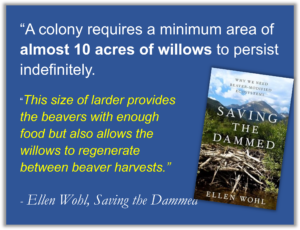
CONSIDERING THE BEAVER
Informed by the research and reading provided below, good results achieved by others, and years of monitoring beaver families throughout eastern Oregon, each of our beaver habitat projects considers these three areas:- Sufficient food established Day 1 of beaver arrival for long term site longevity. Where the rate of overall willow generation is equal to - or exceeds - the rate of beaver forage within a territorial reach. We strive for riparian planting within the safest distance (30' to 50') from the water's edge, along 1/2 mile stream reaches (the length of a 'typical' territorial beaver home base) for a total of 8,000 to 12,000 trees and shrubs established at Day 1 of beaver arrival.
This amount of forage provides food for individual fitness and dam/den construction over years, and provides the space and time needed for vegetation to regenerate between beaver harvests.
2. Protection from browse. If beavers are in the system, we assume that plantings will be eaten. To prevent this most of our cuttings are caged by 2"x4" fencing during a 3 to 5 year period of tree establishment. Once enough vegetation is established, the caging is removed. Without this protection, vegetation doesn't get a foothold. Beavers may move in for a while, but over time they're forced to leave the site when vegetation regeneration can't keep up.
3. Primary diet of native poplar species. Though beavers will make use of many different tree, bush, aquatic and herbaceous species the most nutritious and delicious beaver favorites universally include these riparian natives: willow, cottonwood and aspen.
Care for the beavers and they'll care for your stream.
BEAVER FOOD AND FORAGE REQUIREMENTS - READING AND RESEARCH REPORTS
| ARTICLE (Click to view) | CITATION |
|---|---|
| 1. A study of beaver colonies in Michigan. Journal of Mammalogy, Glenn Bradt, 1938 | “It’s estimated that one acre of poplar will support an average colony of 5 animals for 1 to 2.5 years, depending on the stand of poplar and other factors.” “If we use 1500 trees per acre as a standard, and assume that one beaver will cut 216 trees per year on the average, one acre will support one beaver for about 7 years, or 7 beavers for one year.” |
| 2. Simulation modeling to understand how selective foraging by beaver can drive the structure and function of a willow community. Ecological Modeling, Raúl Peinetti, et al., 2009 | Given a site where all stems were equally available, the model suggested a simulated beaver family of 2 adults, 2 yearlings, and 2 kits required a minimum of 9.9 acres of willow (stems spaced 10.7 sf) to persist in a steady state. |
| 3. Beaver Habitat Selection for 24 Yr Since Reintroduction North of Yellowstone National Park Montana State University, Scrafford, et al., 2018 |
Willow cover and height were positively associated with colony longevity. Numerous other influencing variables included secondary channels, sinuosity, stream depth, and sandbar width. The study found 7.5 years of colony persistence at sites with 100% of willow coverage (and other beneficial factors). |
| 4. Felling and foraging: results of the first year of beaver (Castor fiber) activity in an enclosed Scottish site Lutra, Jones, et al., 2003 | Yields approximate felling rates of 0.5 trees per beaver per day at the Willow Carr Site and 0.8 trees per beaver per day at the Lake Site. |
| 5. The World of the Beaver - Excerpt on food, pages 107-109 Dr. Leonard Lee Rue III, 1964 | One beaver requires 22 to 30 ounces of aspen bark per day for food. An aspen tree takes about 6 to 7 years to grow to 1 inch diameter. At that size, it will produce about 2.85 pounds of food. One acre of 1- to 2-inch-diameter aspens will yield about 5,840 pounds of food, or enough to support ten beavers for one year. |
| 6. North American Beaver (Castor canadensis): A Technical Conservation Assessment February 6, 2007 Steve Boyle and Stephanie Owens, BIO-Logic Environmental, 2007 Prepared for the USDA Forest Service, Rocky Mountain Region, Species Conservation Project | P.16 cited Ringelman (1991): “estimated that a colony of six beavers can be supported by 1.6 ha (3.9 Acre) of aspen, 4.9 ha (12 acre) of willow, or an intermediate combination of the two.” |
| 7. Spatial and Energy Requirements of Beavers, Ohio Journal of Science, Fred Brenner 1967 | One acre of aspen produces 5,840 lbs of food, which would be sufficient to sustain 10 beavers for 442 days. |
| 8. Saving the Dammed, excerpts from “About Beavers” - February Chapter, pages 26-27, Dr. Ellen Wohl, CSU, 2019 (See also bibliography reading p. 152 related to that chapter.) | P. 27 A colony requires a minimum area of almost 10 acres of willows to persist indefinitely. This size of larder provides the beavers with enough food but also allows the willows to regenerate between beaver harvests. |
| 9. Beaver Carrying Capacity of Certain Streams in North Park, Colorado, Duncan MacDonald, 1956 | Thesis paper with helpful references to research on beaver forage needs (captive and wild), and measurements around how much ingestible food exists on Aspen of different stem sizes. |
Good Habitat is Essential for Long-term Beaver Occupancy
In our efforts to support beavers on Oregon’s high desert landscapes, we have to take a look at the factors that are limiting their restablishment from a “landscape” perspective. Then we can consider the beaver’s own natural behaviors, and their motivations for “sticking around” in a given stream reach.
We first ask ourselves the question - why do beavers often just 'pass through' stream reaches, instead of settling down and sticking around?
Then, through our own monitoring, stream surveys and research — and those published by others — we look deeper from the beaver's perspective:
Why does a beaver (or beaver pair) decide to “settle” in a certain stream and make the area his or her own— a place to invest in dam building and den building with the long-term goal of raising a family?
We believe that just like young human families who seek out a “starter home” in a community with good schools, nearby amenities, welcoming neighbors and jobs to provide for the family, beavers also seek out similar basic conditions in order to settle down and build a family.
Here are some 'beaver basics' in considering where to build their new home base:
- safety (hydrology) from predators,
- shelter (good denning and refuge holes),
- abundant food supplies (for many mouths over many years), and
- human tolerance
In Oregon high desert streams, finding these ideal "let’s settle here and raise a family" conditions is difficult for beavers.
Don't equate 'signs of beaver activity' to 'beavers are successfully settled here'
What Do Beavers Need to Succeed?
Although beavers are master engineers, very resourceful and adaptable, the obstacles caused by centuries of unnatural changes to their landscapes are difficult to overcome.
That's why removing the obstacles to beaver success, and addressing the missing conditions that beavers need to do their thing, can help beavers gain a foothold for long term establishment and natural recovery.
Recent, natural beaver re-establishment around eastern Oregon (Hay Creek, Marks Creek, Bridge Creek and Pine Creek), has proven this idea: that long-term, natural beaver recovery is possible if the right conditions are in place.
Building "BeaverHOODs" can help put us on the path to beaver success.
